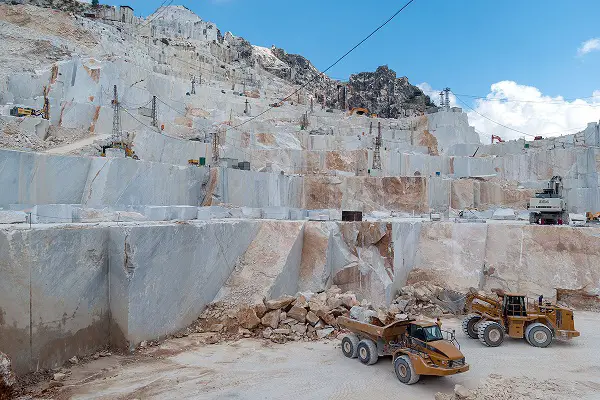Fascinating Marble Quarrying in the Italian Alps
Fascinating Marble Quarrying in the Italian Alps

Carrara Marble is a type of white or blue-grey marble of high quality, popular for use in sculpture and building decor.
It is quarried at the city of Carrara in the province of Massa and Carrara in the Lunigiana, the northernmost tip of modern-day Tuscany, Italy.
Carrara marble has been used since the time of Ancient Rome.
In the 17th and 18th centuries, the marble quarries were monitored by the Cybo and Malaspina families who ruled over Massa and Carrara. The family created the Office of Marble in 1564 to regulate the marble mining industry.
The Basilica of Massa is built entirely of Carrara marble and the old Ducal Palace of Massa was used to showcase the precious stone.
Carrara marble has been used since the time of Ancient Rome. In the 17th and 18th centuries, the marble quarries were monitored by the Cybo and Malaspina families who ruled over Massa and Carrara. The family created the Office of Marble in 1564 to regulate the marble mining industry. The city of Massa, in particular, saw much of its plan redesigned (new roads, plazas, intersections, pavings) in order to make it worthy of an Italian country’s capital. Following the extinction of the Cybo-Malaspina family, the state was ruled by the House of Austria and management of the mines rested with them. The Basilica of Massa is built entirely of Carrara marble and the old Ducal Palace of Massa was used to showcase the precious stone.
By the end of the 19th century, Carrara had become a cradle of anarchism in Italy, in particular among the quarry workers. According to a New York Times article of 1894, workers in the marble quarries were among the most neglected labourers in Italy. Many of them were ex-convicts or fugitives from justice. The work at the quarries was so tough and arduous that almost any aspirant worker with sufficient muscle and endurance was employed, regardless of their background.
The quarry workers and stone carvers had radical beliefs that set them apart from others. Anarchism and general radicalism became part of the heritage of the stone carvers. Many violent revolutionists who had been expelled from Belgium and Switzerland went to Carrara in 1885 and founded the first anarchist group in Italy. In Carrara, the anarchist Galileo Palla remarked, “even the stones are anarchists.” The quarry workers were the main protagonists of the Lunigiana revolt in January 1894.
,
Carrara marble has been used since the time of Ancient Rome. In the 17th and 18th centuries, the marble quarries were monitored by the Cybo and Malaspina families who ruled over Massa and Carrara. The family created the Office of Marble in 1564 to regulate the marble mining industry. The city of Massa, in particular, saw much of its plan redesigned (new roads, plazas, intersections, pavings) in order to make it worthy of an Italian country’s capital. Following the extinction of the Cybo-Malaspina family, the state was ruled by the House of Austria and management of the mines rested with them. The Basilica of Massa is built entirely of Carrara marble and the old Ducal Palace of Massa was used to showcase the precious stone.
By the end of the 19th century, Carrara had become a cradle of anarchism in Italy, in particular among the quarry workers. According to a New York Times article of 1894, workers in the marble quarries were among the most neglected labourers in Italy. Many of them were ex-convicts or fugitives from justice. The work at the quarries was so tough and arduous that almost any aspirant worker with sufficient muscle and endurance was employed, regardless of their background.
The quarry workers and stone carvers had radical beliefs that set them apart from others. Anarchism and general radicalism became part of the heritage of the stone carvers. Many violent revolutionists who had been expelled from Belgium and Switzerland went to Carrara in 1885 and founded the first anarchist group in Italy. In Carrara, the anarchist Galileo Palla remarked, “even the stones are anarchists.” The quarry workers were the main protagonists of the Lunigiana revolt in January 1894.
This site contains product affiliate links. We may receive a commission if you make a purchase after clicking on one of these links.


